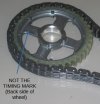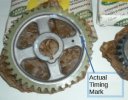Hi Team .
So I spent Xmas holidays replacing rhe camshaft in my 3500. Kit was from Wins.I am certain I lined up the marks correctly when putting the new timing sprockets and chain on.
The engine now won't rev above 3000rpm at which point there us engine shake and backfiring from rhe exhaust.
The engine never ran right before hand so I don't have a benchmark.
Could it be a faulty distributor not advancing, or have I set the cam position wrong?
Car starts, idles and srived fine up to 3000rpm Timing set to 6dbtdc and dwell angle at 27 degrees. You can see the timing advance with a timing light at increased revs. Could the weights in the distributor be frozen?
Carbs are set right.
So I spent Xmas holidays replacing rhe camshaft in my 3500. Kit was from Wins.I am certain I lined up the marks correctly when putting the new timing sprockets and chain on.
The engine now won't rev above 3000rpm at which point there us engine shake and backfiring from rhe exhaust.
The engine never ran right before hand so I don't have a benchmark.
Could it be a faulty distributor not advancing, or have I set the cam position wrong?
Car starts, idles and srived fine up to 3000rpm Timing set to 6dbtdc and dwell angle at 27 degrees. You can see the timing advance with a timing light at increased revs. Could the weights in the distributor be frozen?
Carbs are set right.



